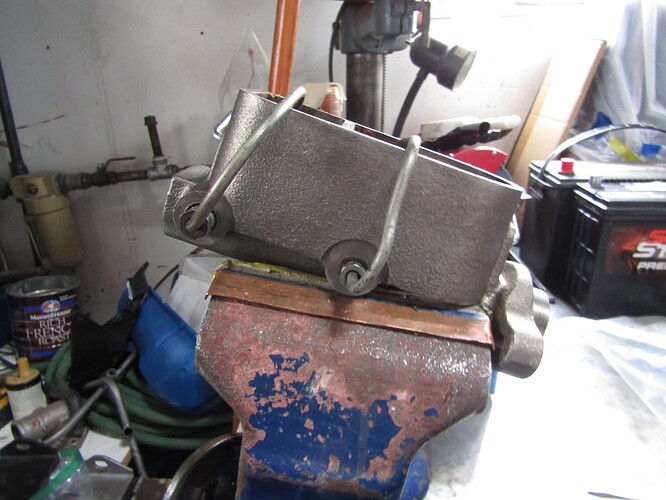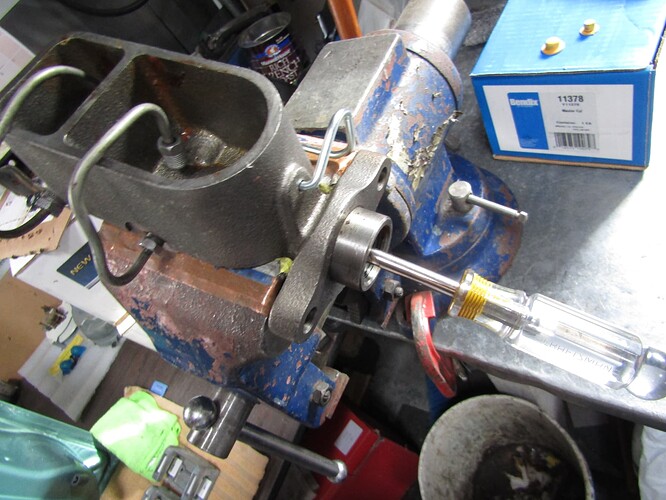Why does the master need to be bench bled? I’m guessing it is too hard to drive all that air down and out? In the good book using pressure bleeding it says to break the lines loose to bleed the master until it stops bubbling at the connection.
I find it easier and cleaner to do on the bench. Its also faster if your replacing the master to bench it first before installing it. Cracking the lines to bleed can introduce more air into the rest of the system from the master and make a mess of fluid where you do not want it.
Not that it matters on our cars but newer stuff with abs can be harder to bleed the master installed vs on the bench as well. Thus I’ve become accustomed to just bench bleeding first
Bill, I have the same device. Bought it about two years ago and also have been picking up the various adapters to mate up to the various master cylinder designs in my fleet. I don’t have as good up luck with the j-hooks for the flat plate adapters. Instead, I use either a pair of c-clamps or one of those tension style construction clamps to hold the lid on. The adapters on the later model stuff work great as they usually just take the place of the filler cap such as on my 88 T-Bird or my wife’s Toyota Van.
There are 2 stages of air clearing that must take place. The first is the master cylinder. The 2nd is the brake lines and calipers themselves.
If you don’t clear the air out of the MC, you will never push fluid through the lines to clear the air. So, you ‘bench bleed’ the MC to make sure the MC ports have no remaining air in them. You must then be quick and clever when you install it such that the fluid doesn’t dribble out of the ports between the time you take it off the bench and install the lines. If the fluid drains out of the ports, you just undid the bench bleed and have to start over because now you have air in the ports.
I never ‘bench bleed’ on a bench. I bench bleed on the car, with the lines ready for quick swap. I then back out either the front or the rear (only one at a time) and bleed that line’s attachment to the MC until fluid comes out in good flow right where the line goes into the MC. To do this 2nd step I carefully do each connection to the MC one at a time by having my assistant press the pedal first; then I crack the fitting just enough to get either air flow or fluid flow (if you did the installed bench bleed well and quickly cinched up the lines well it’s only fluid or little air). I then know that the MC ports are cleared of air, and move on to the lines. Now I do the closest circuit first (usually LF), then the RF, then last the rear.
You brought up ABS systems, so I’ll add a bit about ABS systems you don’t want to vacuum bleed. If it has a separate return line that goes into the master cylinder above the fluid level, you don’t want to attempt to vacuum bleed or flush that system. I can’t speak for all systems like that, but there is at least one where the vacuum at the bleed screw will draw air through the return line instead of drawing fluid though the master cylinder and brake control module. Once that happens you will have a difficult, but not impossible time bleeding it with a pressure bleeder a scan tool. You won’t be able to bleed it by pumping the pedal.
A few pics how I tilt master during bench bleeding using “special bleeding tubes” and manual adapter!
I’ve tried a bunch of different ways, and speed bleeders have been the easiest and most efficient way on my Cougar. On late model stuff with the plastic screw top master cylinders I use a Motive.
How do you keep them from sucking in air around the threads?
My understanding of the purpose of bench bleeding a MC is so that you can keep the MC level during the process so it will be able to clear all the air bubbles out… A lot of time our MC will sit tilted up when installed in the vehicle so bleeding the MC like that might not fully clear all the air bubbles…
I think I just used some thread sealant or PTFE paste around the bleeder threads. Teflon tape maybe could work, but would probably get chewed up from repeatedly loosening/tightening the bleeders.
For bench bleeding the master cylinder (at least the one I installed: Raybestos MC36251) it included plugs for the brake line ports, and the instructions stated to bleed with the plugs in place. It was not necessary to route lines back into the reservoirs. I also used this tool for working the master cylinder, which made the job much easier.
The Teflon tape is definitely short term. I like that when you’re done you can unwind the visible strands or ribbon from the bleeder, and someone would have to look really close to tell it was even there.
It may have some benefit to keep the bleeder from seizing over the years, but I have more important things to do than to develop an experiment to test it.
My wife. The best foot pedal bleeder EVER!
And I brag to everyone about it. I will never bleed brakes without her. I have always ended up with a perfect pedal, EVEry time.


